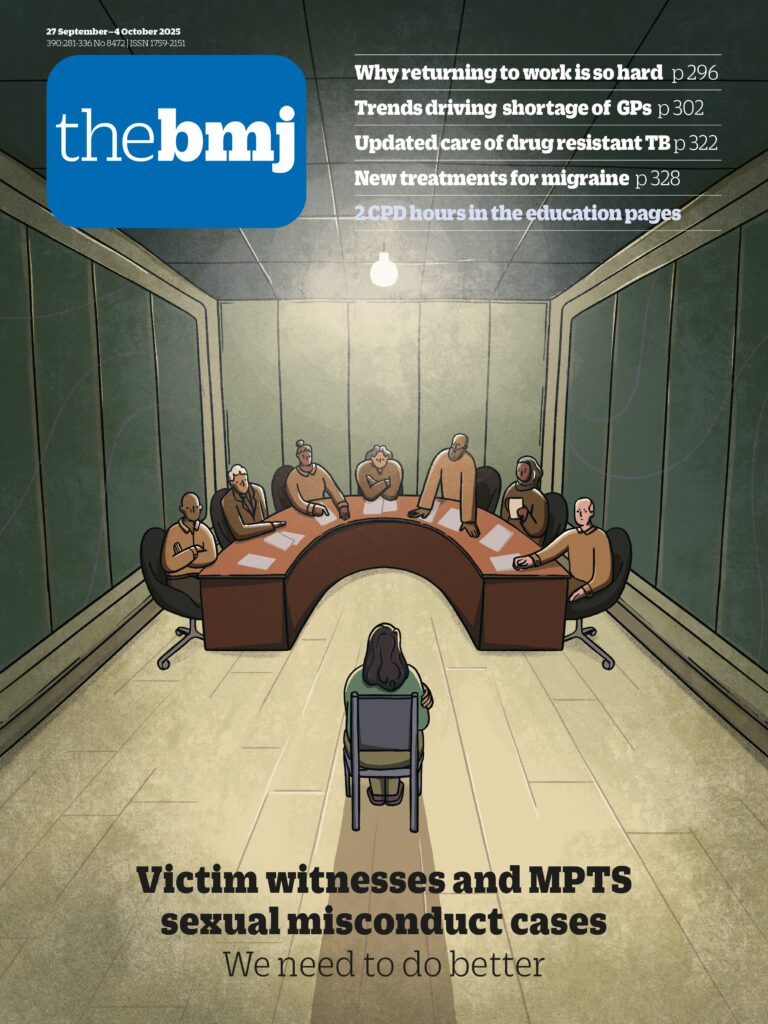The United Kingdom currently ranks 104th in the world for gender health inequality.1 A London School of Economics (LSE) report published this year (Barriers to Women in Accessing Healthcare in the UK) highlights an uncomfortable truth: women’s health remains underprioritised, underfunded, and difficult to access, particularly for gynaecological concerns that aren’t related to cancer.2 We need action to deliver integrated women’s healthcare in the community. The rollout of Women’s Health Hubs equipped with advanced diagnostics3 across the UK will help to achieve this provision of care.
Women’s Health Hubs offer a scalable but locally modifiable, patient centred solution. These integrated, community based centres are co-located with sexual health, menopause, and gynaecology services.4 By embedding services locally, they reduce access barriers and streamline care. Beyond gynaecology, the cohesiveness of health hubs with other specialties and allied healthcare professionals is essential to their success. Women’s health is more than just gynaecological care—a holistic multidisciplinary approach must be embedded in these hubs.
One such model already exists in Wales. The Bevan Exemplar project in Ceredigion piloted an advanced community gynaecology clinic to manage unscheduled bleeding associated with hormone replacement therapy. This community based service, combining clinical assessment with point-of-care ultrasonography, reduced the need for follow-up, freed radiology capacity, and avoided escalation to cancer pathways for benign conditions.5 It released £73 968 in annual resource savings from one consultant session a week and freed up 276 additional cancer diagnostic appointments by streamlining care.5 The model removed the need for multiple appointments, improved access in rural areas, and showed that high quality diagnostics can be safely and efficiently delivered outside of hospital settings.5
Consultant delivered care in the community, with access to point-of-care ultrasound scanning, is a prudent model that improves equitable access to care, and it must be embedded firmly in practice.4
Good gynaecological care exists, and we must highlight that, but too few people can access it. Although secondary care offers excellent specialist led services, demand has far outstripped capacity.2 Care is often fragmented, leaving women to endure years lived with pain or disability unnecessarily because of common, easily diagnosed gynaecological conditions. These delays exacerbate women’s suffering as symptoms worsen, treatment needs escalate, and quality of life is eroded.
A community based response
The LSE report showed troubling data on unmet health literacy: women report having inadequate information about menstrual health and menopause.1 In line with the inverse care law, women with a low income, despite having higher morbidity, consult health professionals less often. They tend to be constrained by caring responsibilities, work demands, and stigma. Women’s Health Hubs, designed with embedded education, can help to confront this by offering trusted information, earlier healthcare engagement, and flexible access.
If Women’s Health Hubs are to play a central role in reducing inequalities, they must be designed with equity as a cornerstone. This requires genuine co-production with women from socially disadvantaged and racially minoritised backgrounds, ensuring services reflect their lived experiences and needs. Working alongside charity and third sector groups will be invaluable for engagement.
Evaluation and monitoring equity is essential. Through disaggregated data, service user feedback, audit, and governance pathways and most of all reflection and insight, hubs can proactively drive inclusion and fairness in women’s health. Women’s health hubs must reflect the communities they are embedded into, while meeting nationally agreed standards, which need to be established for early triage.
Critically, these hubs must include advanced ultrasound diagnostic capabilities.6 This enables faster, more accurate diagnoses, particularly for benign conditions, reducing pressure on secondary care. Co-working with specialist general practitioners, gynaecologists, and sexual health consultants in a community setting could reduce referrals to hospital secondary care.
Virtual hysteroscopy combined with transvaginal ultrasonography could fill a diagnostic gap between conventional imaging and invasive hysteroscopy for investigating abnormal bleeding, improve preoperative planning, and streamline community and outpatient triage.7 3D ultrasound images can support the timely diagnosis of polyps, fibroids, and endometrial abnormalities, thereby often avoiding escalation to hospital based hysteroscopy.
These innovations align strongly with the Prudent Healthcare approach in Wales: minimally invasive, co-produced, efficient, and equitable.6 Further evaluation is needed now to assess the value and equity of community ultrasound technology.
Women’s health concerns are too often deprioritised or siloed. Investment in integrated, technologically enabled, and community embedded services can create a more equitable, responsive model of care. To do this, we must scale up successful hub models, particularly in rural and underserved areas. Ultrasound skills can be championed with specialist training in community gynaecology. Health literacy can be raised through education, information, and patients’ open discussion of care.
Women’s Health Hubs with diagnostics and embedded within communities are a response to long-standing gaps in access and equity. This realignment of services can ensure timely and appropriate care. The challenge now is to translate vision into action.
Footnotes
-
Competing interests: IF is chair of the Bevan Commission (non-remunerated). AT is vice president of the British Society of Gynaecological Imaging. No other competing interests to declare.
-
Artificial intelligence use: All intellectual property, ideas, and references are the work of Alan Treharne. Artificial intelligence was used to assist in restructuring and refining the text to improve readability.
-
Provenance: not commissioned, not externally peer reviewed.
References
- ↵
- ↵
Royal College of Obstetricians and Gynaecologists. Left for too long: understanding the scale and impact of gynaecology waiting lists. London: RCOG; 2023. Addressing waiting times gynaecology services | RCOG.
- ↵
Wales Executive NHS. The NHS Wales Women’s Health Plan. A 10 year plan for women’s health in Wales. 2025. https://performanceandimprovement.nhs.wales/functions/networks-and-planning/womens-health/the-womens-health-plan-for-wales
- ↵
- ↵
Treharne A. Advanced community gynaecology: using point of care diagnostics to deliver prudent local healthcare in Ceredigion and Hywel Dda [Bevan Exemplar Project]. Cardiff: Bevan Commission; 2024. Enhanced Community Gynaecology Service—Bevan Commission.
- ↵
- ↵

